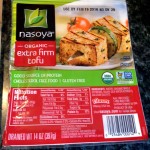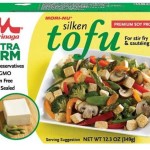Tofu is like a blank canvas. Untouched it’s bland. Yet tofu can absorb flavors and take on a range of textures, making it a very versatile food that can be both delicious and satisfying. Here are some general tips to help you achieve good taste and texture.
These tips are mainly for preparing “regular” tofu to ready it for common cooking methods such as baking, broiling, grilling, pan and stir frying. So first you need to understand a little about the types of tofu.
TIP 1 then is to choose the right type of tofu for your dish. Buying tofu can be a little confusing. There are 2 general categories of tofu: REGULAR and SILKEN. Within each of these categories are gradations of soft, medium, and firm.
Use REGULAR if you want the tofu to retain some shape. Regular tofu is found in the refrigerated section of the grocery store.
The firms – firm, extra firm, and super firm – are what you’ll likely use most often for baking, broiling, grilling, pan and stir frying. When cubing or using small pieces, and for grilling, use extra or super firm. Personally I tend to use these firmest varieties most often. I’ll use a plain firm, or even medium, for crumbling (e.g. ricotta, scrambles, salads), though extra firm here as well.
There’s also “soft” regular tofu. Personally I rarely buy regular soft tofu, except occasionally for use in Asian-style soups. The line between soft and silken tofu is blurry and in a pinch you can use soft in place of silken as described below.
Use SILKEN for blending up into sauces, dips, and desserts (e.g. pie fillings, mousse, puddings). Silken tofu also can be used to replace eggs in many recipes. Sometimes silken is found packed in water in the refrigerated section along with the regular tofu, but often it’s in vacuum packed, aseptic boxes on the shelves with the Asian food. Non-refrigerated silken tofu tends to be the creamiest, but it’s not as commonly found in mainstream groceries, so you may need to go to an Asian market or “natural foods” store. There’s not that much difference between soft and firm varieties of silken tofu, so unless your recipe specifies, don’t worry about which firmness you buy. Again, do not be confused – all silken tofu is “soft.” If you need an “extra firm tofu” to make something solid, do NOT buy “Silken Extra Firm;” It will fall apart.
OK then, the remaining tips are only for regular (i.e. not silken) tofu.
TIP 2 – Always drain and press your tofu before cooking with it. Reducing the water content leaves the tofu open to absorb flavors as well as improves the texture. Drain and press is the minimum you’ll want to do. Simply drain out the water the tofu comes packed in, then wrap it in a clean dish towel or paper towel, and place it between two plates. Put a weighted object (such as a can or pan) on the top plate and let sit for about 15 minutes. Then pour off the released water and pat the tofu dry with a towel.
TIP 3 – Dry fry before marinating and the tofu will really absorb the flavor! Dry-frying in a non-stick or well seasoned cast iron skillet without any oil will remove the water from the tofu really well. (Without the oil, the tofu will stick to the pan, which is why you need to use non-stick or seasoned cast iron.) To dry-fry, use a medium-low heat and let the tofu sit a couple minutes on each side until the water sizzles out and each side is slightly golden. Pressing the tofu down with a spatula helps.
TIP 4 – Freezing then thawing tofu changes the texture making the tofu very dense and chewy. This method also is great for extracting the water content, enabling the tofu to soak up seasonings and marinades. (Many people love this technique so much, they won’t prepare tofu any other way.) Just put your package of tofu in the freezer for at least overnight. (You could leave it in there for months.) The day you want to use it, take it out and allow at least 3-4 hours for it to thaw completely. Then drain and press and watch the water gush out. You also could just squeeze the tofu by hand over the sink.
TIP 5 – Quick broil after baking. If you want to give your baked tofu a chewier texture, just broil for a few (about 3) minutes at the end of your baking time.
TIP 6 – This one is very basic, yet important. Cut tofu into appropriate sized pieces. Whatever size and shape you choose (rectangular slices, triangular slices, strips, cubes or anything else you come up with), keep in mind:
- As in cooking anything, you want to cut the tofu into uniform size pieces for even cooking.
- You also want to consider what you’re cooking it with. E.g. cubes or strips work great for stir fries. Just make sure their size works with the other food.
- If you’re going to put tofu on the grill, make sure the pieces are at least ½ inch thick. Typically when I’m baking or pan frying, I’ll cut a standard tofu block into eight slices. For the grill, I’ll cut into only six slices.
TIP 7 – well this is perhaps multiple tips, but there are several basic cooking techniques that especially apply to tofu. When marinating, longer is better. Try to give tofu at least an hour in marinade. Regardless whether you’re baking, broiling, grilling, or pan frying: 1) don’t crowd your pans when you cook; 2) don’t move the food around constantly; allow time for each side to sear/cook; and use high enough/appropriate heat. In most cases, you’ll want your tofu to get golden and perhaps a little crispy on the outside.



Thanks for these tips. I’ve become very sensitive to milk products but most of the foods I enjoy are dairy based. Can you recommend a good book of soy or other recipes that can pass for regular? Thanks
You might be able to replace dairy in dishes you’re currently making. Just swapping a non-dairy milk (such as almond, soy, or others), cream, butter, or yogurt for the dairy versions works. Replacing cheese can be a bit more involved. There are LOTS of great vegan cookbooks out there. One that comes to mind, which has fairly easy traditional meals, is “Chloe’s Kitchen” by Chloe Coscarelli. Another is “Veganomicon” by Isa Chandra Moskowitz & Terry Hope Romero. Good luck.
Thanks so very much!
I froze and thawed extra firm tofu and the texture was like mushy cornbread even after cooking. Help ?
Once the tofu is thawed, you need to press or squeeze the water out of it. It’s best to do this over the sink as there will be lots of water.
In addition to marinating tofu, I like to roll my tofu pieces in a mixture of spices and corn starch. Crisps up nicely in the skillet.
Yes, that works well!